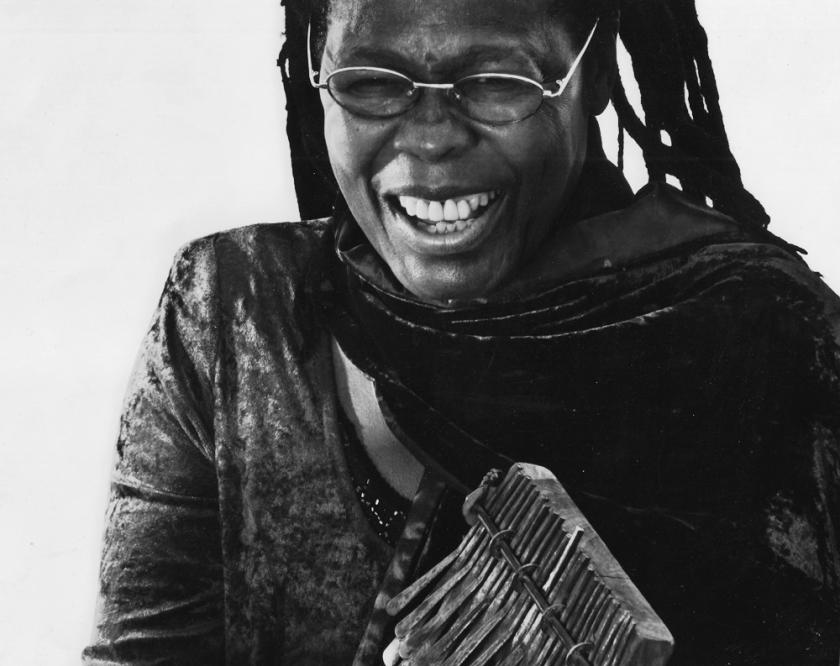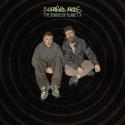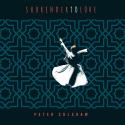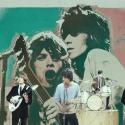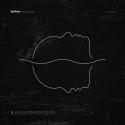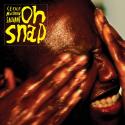Until now, hearing the extraordinary “Ratidzo” was all-but impossible. The original single is rare and has not been reissued before. It begins with a plaintive whistle which sets the scene for a hypnotic and beautiful rotating pattern of single notes possibly played on a gamelan-style instrument. Rhythmic accompaniment comes from a form of shaker. It is not instantly possible to place where this music is from. Eastern Asia? Hawaii? The next track is similarly mysterious, but the addition of a vocal suggests Africa. The singular talent responsible for these outstanding performances is Zimbabwe’s Stella Chiweshe
Chiweshe would reach beyond her home country when she and her band Earthquake were heard on the 19 March 1988 John Peel Show. The four-track session was played during a show which roamed through “Goin' Home” by Ken Colyer's Jazzmen, hip hop from Rob Base and D.J. E-Z Rock, Morrissey’s "Margaret on the Guillotine” and British indie fare from 14 Iced Bears, McCarthy and Stump. A typically eclectic show, then.
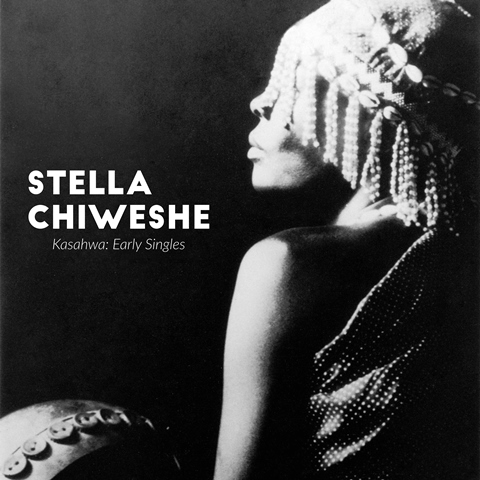 Chiweshe was in the UK following the release of her first album Ambuya?, which came out in Britain on the Globe Style label in 1987. Its sub-title was “Zimbabwe's Queen of the Mbira”, a reference to the hand-held instrument with a wooden, usually resonant, base onto which are fixed a series of springy metal bars. Plucking each with the thumbs produces individual notes. The mbira also featured in the musical arsenal of fellow Zimbabwean Thomas Mapfumo, another of Peel’s favourites.
Chiweshe was in the UK following the release of her first album Ambuya?, which came out in Britain on the Globe Style label in 1987. Its sub-title was “Zimbabwe's Queen of the Mbira”, a reference to the hand-held instrument with a wooden, usually resonant, base onto which are fixed a series of springy metal bars. Plucking each with the thumbs produces individual notes. The mbira also featured in the musical arsenal of fellow Zimbabwean Thomas Mapfumo, another of Peel’s favourites.
Kasahwa: Early Singles is a new eight-track compilation by Chiweshe drawing from singles released by the Shungu and Zimbabwe labels before her international breakthrough. Nothing collected has been previously reissued. She is heard in the raw – this eerie, spectral music is very different to that of Ambuya?
Within the pre-independence country, Chiweshe was an anomaly. No man would make a mbira for her. It was the instrument of the majority Shona group, and women were not meant to play it. No man would teach her to play. Nonetheless, she began playing and recording in the early 1970s. The earliest tracks on Kasahwa were issued by the independent Shungu label and pressed by the Teal Recording Company, a Bulawayo-based EMI subsidiary founded in 1959. Shungu was an early home of The Green Arrows, the first local band to issue an album. Thomas Mapfumo’s Hallelujah Chicken Run Band was also on Shungu. As a female musician Chiweshe was a rarity, but the music business infrastructure around her was, though evolving, one which was established.
Based on what’s heard here – she has said that she recorded over 20 singles between 1975 and 1978 – Chiweshe was already fully formed before she reached European ears in the second half of the 1980s. Each of the eight tracks is so compelling that it is impossible not to be affected by their quiet power. However, they are raw and sparse, and bear little relationship with much of the polished material issued from 1987 onwards.
 It is frustrating that what’s collected on Kasahwa is blithely described as “spanning the period 1974 to 1983,” with “Kasahwa” itself noted as being her debut single and originally released in 1974. It is essential to know when these singles were issued, especially with the context of Zimbabwe becoming independent in 1980. The booklet has a few paragraphs of text, but lacks liner notes as such.
It is frustrating that what’s collected on Kasahwa is blithely described as “spanning the period 1974 to 1983,” with “Kasahwa” itself noted as being her debut single and originally released in 1974. It is essential to know when these singles were issued, especially with the context of Zimbabwe becoming independent in 1980. The booklet has a few paragraphs of text, but lacks liner notes as such.
Once it is accepted that “Kasahwa” and its A-side “Nhemamusasa” were released in 1974 and with the additional knowledge that the “Gomoriye” / “Gwendurugwe” single was subsequently issued by the same label, it appears these four tracks were issued before independence. The “Mayaya Part 1” / “Mayaya Part 2” (edited together as one track here) and the “Musarakunze” / “Chipindura” singles have catalogue numbers between those of other performer’s singles on the same label issued in 1980 and 1988, so the tracks therefore must be post-independence. Similar inferences with the track “Ratidzo” cannot be made as there is no image of the single in the booklet. “Gomoriye” and “Gwendurugwe” were produced by an “A K Mapfumo” – a name which also appears on Thomas Mapfumo records. Is there a familial relation to Thomas Mapfumo?
Kasahwa’s issuing label ought to have detailed the sources, stated when the tracks were issued and how they relate to each other (more precisely than the deductions made here). Buyers want to know these things. They are selling points. Setting this aside, Kasahwa: Early Singles reveals a side to Stella Chiweshe which previously was barely known. It is a joy.
- Next Week: Keychains & Snowstorms – the significant 10-disc Soft Cell box set

